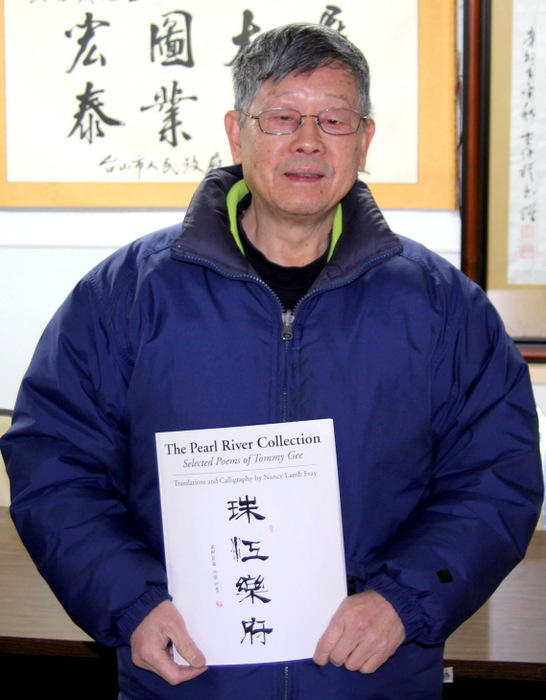By Nancy Fray, translator and calligrapher of The Pearl River Collection, Selected Poems of Tommy Gee
When Tommy Gee and I first met, I had been studying Calligraphy for three years. I was being taught to copy the classic Tang poems with a brush in Li Shu style. I wanted to compose something different – something that would stand out. I also was beginning to study Mandarin and was curious to understand exactly what I was writing. We talked about translating some of his poems to further my education. As this project progressed, I realized that I wanted to introduce his beautiful poetry to English speaking readers. We decided to proceed with this book.

Poet Tommy Gee with his new book The Pearl River Collection (photo by David Li).
Tommy’s verse contains vivid colors and strong emotions which lends itself to magnificent Calligraphy compositions. I have included several pieces of my artwork in this book hoping to further illustrate how moving his writings are.
Tommy’s works are written in old literary Chinese. This method reduces length by not using unnecessary words. There are various ways of translating them due to their compressed and ambiguous meanings. Beneath my English translations you can sense the essential word structure that gives Chinese poetry its pattern.
Tommy prefers to write in the Tang and Song styles. He finds that Tang is the most dominate of all the styles. People still use this method of writing today. However, the Song style is just as dominate. A thousand years later people still use “Ci” formats in their writings.
In translating Tommy’s poetry; I had to move from one culture to another in order to translate it for English language readers. I often had to stray from the original character meanings. Therefore, some idioms weren’t directly translated though what they express is certainly present.
Distinctive features found in Tommy’s writing are nostalgia for his motherland as well as his deep love for America where he has been a citizen for over fifty years. In “Song to the Bald Eagle 2002”, and in “Thoughts on the Statue of Liberty’s Reopening 1984” he shows his faith in liberty and a strong patriotic commitment to America.
Tommy felt much torment during the trouble on Hai Nan Island that occurred in 2001 between America and China. His poem “Approaching Hai Nan Island in June 2001” 《六月海南即事》 illustrates this:
北美山河好,神州侯物新。
长教风日美,莫令海扬尘。
America’s land is fine,
Everything in China is renovated.
I hope the weather remains peaceful and beautiful,
Please, both sides don’t stir up the dust in the South Sea.
I want to thank the following people for their personal support and expertise. My friend and language instructor, Jun Wang proofread and gave up valued time to give me in-depth background on the historical events and literary references in Tommy’s poetry. My Calligraphy teacher and President of CAFAS, Mike Mei, took time to instruct me on how to create beautiful pieces of art work. My husband, Walter, who did the photography for this book, gave me constant encouragement and support. My brother Zachary Leonard gave me his interest, backing and helped with publishing resources.
I want to thank members of The Chinese Calligraphy Association of Boston for their interest and support in this project. I also want to express deep gratitude to The Chinese-American Fine Arts Association and their members without whom none of this would have been possible. This is where I study Calligraphy with Mike Mei and where Tommy and I met. Both of these organizations promote the appreciation of Chinese Arts, and also value and encourage cultural exchange.


